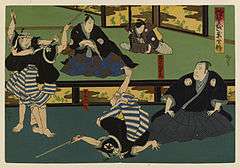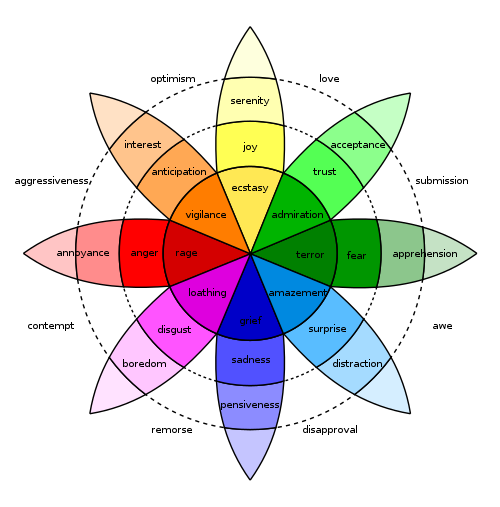Revenge
Revenge is defined as the act of committing a harmful action against a person or group in response to a grievance, be it real[1] or perceived.[2] Francis Bacon described revenge as a kind of "wild justice" that "does... offend the law [and] putteth the law out of office."[3] Primitive justice or retributive justice is often differentiated from more formal and refined forms of justice such as distributive justice and divine judgment.

Function in society


Social psychologist Ian Mckee states that the desire for the sustenance of power motivates vengeful behavior as a means of impression management: "People who are more vengeful tend to be those who are motivated by power, by authority and by the desire for status. They don't want to lose face".[5][6]
Vengeful behavior has been found across a majority of human societies.[7] Some societies encourage vengeful behavior, which is called a feud.[8] These societies usually regard the honor of individuals and groups as of central importance. Thus, while protecting of his reputation an avenger feels as if he restores the previous state of dignity and justice. According to Michael Ignatieff, "Revenge is a profound moral desire to keep faith with the dead, to honor their memory by taking up their cause where they left off".[9] Thus, honor may become a heritage that passes from generation to generation. Whenever it is compromised, the affected family or community members might feel compelled to retaliate against an offender to restore the initial "balance of honor" that preceded the perceived injury. This cycle of honor might expand by bringing the family members and then the entire community of the new victim into the brand-new cycle of revenge that may pervade generations.[10]
History

Feuds are cycles of provocation and retaliation, fueled by a desire for revenge and carried out over long periods of time by familial or tribal groups. They were an important part of many pre-industrial societies, especially in the Mediterranean region. They still persist in some areas, notably in Albania with its tradition of gjakmarrja or "blood feuds".[11] During the Middle Ages, most would not regard an insult or injury as settled until it was avenged, or, at the least, paid for—hence, the extensive Anglo-Saxon system of weregild (literally, "man-price") payments, which placed a certain monetary value upon certain acts of violence in an attempt to limit the spiral of revenge by codifying the responsibility of a malefactor.
Blood feuds are still practised in many parts of the world, including Kurdish regions of Turkey and in Papua New Guinea.[12][13]
In Japan, honouring one's family, clan, or lord through the practice of revenge killings is called "katakiuchi" (敵討ち). These killings could also involve the relatives of an offender. Today, katakiuchi is most often pursued by peaceful means, but revenge remains an important part of Japanese culture.[14]
Social psychology
Philosophers tend to believe that to punish and to take revenge are vastly different activities:[15] "...One who undertakes to punish rationally does not do so for the sake of the wrongdoing, which is now in the past - but for the sake of the future, that the wrongdoing shall not be repeated, either by him{,} or by others who see him{,} or by others who see him punished".[16] Whereas, to seek revenge is motivated by a yearning to see a transgressor suffer; revenge is necessarily preceded by anger, whereas punishment doesn't have to be.[17]
Indeed, Kaiser, Vick, & Major (2004), point out: "An important psychological implication of the various efforts to define revenge is that there is no objective standard for declaring an act to be motivated by revenge or not. Revenge is a label that is ascribed based on perceivers’ attributions for the act. Revenge is an inference, regardless of whether the individuals making the inference are the harmdoers themselves, the injured parties, or outsiders. Because revenge is an inference, various individuals can disagree on whether the same action is revenge or not." [17]
Belief in a just-world hypothesis is also associated with revenge: in particular, having strong experiences or challenges against beliefs in a just-world, can increase distress and motivate individuals to seek revenge, as a means of justice restoration. [18]
A growing body of research reveals that a vengeful disposition is related to adverse health outcomes: strong desires for revenge and greater willingness to act on these desires have been associated with post-traumatic stress disorder symptoms and psychiatric morbidity. [19]
Proverbs
The popular expression "revenge is a dish best served cold" suggests that revenge is more satisfying if enacted when unexpected or long feared, inverting traditional civilized revulsion toward "cold-blooded" violence.[20]
The idea's origin is obscure. The French diplomat Charles Maurice de Talleyrand-Périgord (1754–1838) has been credited with the saying, "La vengeance est un met que l'on doit manger froid" ["Revenge is a dish that must be eaten cold"], albeit without supporting detail.[21] It has been in the English language at least since the 1846 translation of the 1845 French novel Mathilde by Joseph Marie Eugène Sue: "la vengeance se mange très bien froide",[22] there italicized as if quoting a proverbial saying, and translated "revenge is very good eaten cold".[23] It has been wrongly credited[24] to the novel Les Liaisons Dangereuses (1782).
Its path to modern popularity may begin with the 1949 film Kind Hearts and Coronets which had revenge is a dish which people of taste prefer to eat cold. The familiar wording appears in the film Death Rides a Horse (1967), in the novel The Godfather by Mario Puzo (1969), as if from an "old Klingon proverb" in the film Star Trek II: The Wrath of Khan (1982). The title sequence of the Quentin Tarantino film Kill Bill: Volume 1 (2003) referred to this last movie by again citing it as a Klingon proverb. After that, it appeared in the 2004 version of Man on Fire.
The phrase has also been credited to the Pashtuns of Afghanistan.[25]
Another proverb states, "If you want revenge, then dig two graves".[26] Another version (Chinese: 子不复仇非子也) proposes that a son who does not take revenge for his parents is not a son. Other interpretations include the idea that when pursuing revenge to kill another person, you might as well destroy yourself as well.
In art

Revenge is a popular subject across many forms of art. Some examples include the painting Herodias' Revenge by Juan de Flandes and the operas Don Giovanni and The Marriage of Figaro, both by Wolfgang Amadeus Mozart. In Japanese art, revenge is a theme in various woodblock prints depicting the forty-seven rōnin by many well-known and influential artists, including Utagawa Kuniyoshi. The Chinese playwright Ji Junxiang used revenge as the central theme in his theatrical work The Orphan of Zhao;[27] it depicts more specifically familial revenge, which is placed in the context of Confucian morality and social hierarchical structure.[28]
In literature
Revenge has been a popular literary theme historically and continues to play a role in contemporary works[29]. Examples of literature that feature revenge as a theme include the plays Hamlet and Othello by William Shakespeare, the novel The Count of Monte Cristo by Alexandre Dumas, and the short story "The Cask of Amontillado" by Edgar Allan Poe. More modern examples include the novels Carrie by Stephen King, Gone Girl by Gillian Flynn, and The Princess Bride by William Goldman. Although revenge is a theme in itself, it is also considered to be a genre.[30]
Revenge as a genre has been consistent with a variety of themes that have frequently appeared in different texts over the last few centuries. Such themes include but are not limited to: disguise, masking, sex, cannibalism, the grotesque, bodily fluids, power, violent murders, and secrecy.[31] Each theme is usually coupled with the concept of dramatic irony. Dramatic irony is a literary device in which the audience possesses knowledge unavailable to characters in a novel, play, or film.[32] Its purpose is to intensify the tragic events that are going to unfold by creating tension between the audience and the actions of the characters.[32]
The most common theme within the genre of revenge is the recurring violent murders that take place throughout the text, especially in the final act or scene. The root of the violence is usually derived from the characters' childhood development.[33] Violent murders are seen in many texts ranging from dramas to novels. Carrie, a 20th-century novel written by Stephen King, has examples of this theme that do occur during the final scenes. Another text that incorporates this theme is the 16th-century drama Titus Andronicus by William Shakespeare.
The themes of masking and disguise have the ability to go hand in hand with one another. A character may employ disguise literally or metaphorically. A mask is the literal example of this theme; while pretending to be something one is not is considered to be the metaphoric example. Additional themes that may cause the protagonist and antagonist to develop a masked or disguised identity include sex, power, and even cannibalism. Examples of sex and power being used as themes can be seen in the novel Gone Girl, by Gillian Flynn, as well as the already mentioned drama, Titus Andronicus.[34]
On the Internet
The emergence of the Internet has provided new ways of exacting revenge.[35] Customer revenge targets businesses and corporations with the intent to cause damage or harm.[36] In general, people tend to place more credence in online reviews rather than corporate communications.[35] With technology becoming more readily available, corporations and firms are more likely to experience damage caused by negative reviews posted online going viral. Recent studies indicate this type of consumer rage is becoming more common, especially in Western societies.[37]
The rise of social media sites like Facebook, Twitter, and YouTube act as public platforms for exacting new forms of revenge.[35] Revenge porn involves the public dissemination of intimate pictures and videos of another person's sexual activity out of motives for revenge with the intent of creating widespread shame.[38] Participation in online revenge porn activities incites a sense of pleasure through the harm being caused. The allowance of anonymity on revenge porn sites encourages further incivility by empowering and encouraging this type of behavior.[39] In many instances, the original poster provides the victim's personal information, including links to social media accounts.[38] Online revenge porn's origins can be traced to 2010 when Hunter Moore created the first site, IsAnyoneUp, to share photos of his nude girlfriend.[39]
In animals
Humans are not the only species known to take revenge. There are several species such as camels, elephants, fish, lions,[40] coots,[41] crows, and many species of primates (chimpanzees, macaques, baboons, etc.) that have been recognized to seek revenge. Primatologists Frans de Waal and Lesleigh Luttrellave conducted numerous studies that provide evidence of revenge in many species of primates. They observed chimpanzees and noticed patterns of revenge. For example, if chimpanzee A helped chimpanzee B defeat his opponent, chimpanzee C, then chimpanzee C would be more likely to help chimpanzee A's opponent in a later squabble. Chimpanzees are one of the most common species that show revenge due to their desire for dominance. Studies have also been performed on less cognitive species such as fish to demonstrate that not only intellectual animals execute revenge.[42]
See also
- Crime of passion
- Cycle of violence
- Dirty Work (1998 film)
- Divine retribution
- Eye for an eye
- Frontier justice
- Guilt-Shame-Fear spectrum of cultures
- Honor killing
- Just-world hypothesis
- Karma
- Lawsuit
- Nemesis (mythology)
- Proportionality (law)
- Punishment
- Retributive justice
- Schadenfreude
- Two wrongs make a right
- Vengeful ghost
- Vigilantism
- War
References
- Daladier, Edouard (1995). Daladier, Jean (ed.). "Prison Journal, 1940-1945". Westview Press, 1995: 63 – via ISBN 0813319056, 9780813319056. Cite journal requires
|journal=(help) - "revenge | Definition of revenge in English by Lexico Dictionaries". Lexico Dictionaries | English. Retrieved 2019-07-11.
- "Sir Francis Bacon "On Revenge"". rjgeib.com.
- The Killing Scene: Hamlet 5.2.303–309.
- Michael Price (June 2009). Revenge and the people who seek it. 40. apa.org. p. Print version: page 34. Retrieved 1 October 2010.
- Ian McKee, PhD. 2008. Social Justice Research (Vol. 138, No. 2)
- Ericksen, Karen Paige; Horton, Heather (1992). ""Blood Feuds": Cross-Cultural Variations in Kin Group Vengeance". Behavior Science Research. 26 (1–4): 57–85. doi:10.1177/106939719202600103.
- Richard, McClelland (Summer 2010). "The Pleasures of Revenge". The Journal of Mind and Behavior. 31 (3/4): 196. JSTOR 43854277.
- Brandon Hamber and Richard A. Wilson, Symbolic Closure through Memory, Reparation and Revenge in Post-conflict Societies (Johannesburg: Centre for the Study of Violence and Reconciliation, 1999)
- Helena Yakovlev-Golani (2012). "Revenge - the Volcano of Despair: The Story of the Israeli-Palestinian Conflict". Exploring the Facets of Revenge. p. 83.
- "Peacemaker breaks the ancient grip of Albania's blood feuds". The Christian Science Monitor June 24, 2008
- "Blood feuds and gun violence plague Turkey's southeast". Reuters. May 5, 2009
- "Deadly twist to PNG's tribal feuds". BBC News. August 25, 2005
- Mills, D. E. "Kataki-Uchi: The Practice of Blood-Revenge in Pre-Modern Japan". Modern Asian Studies. 10.
- Flew, Antony (1954). "The Justification of Punishment". Philosophy. 29 (111): 291–307. doi:10.1017/S0031819100067152. JSTOR 3748210.
- Plato. Protagoras. p. 324.
- Schumann, Karina (2010). "The Benefits, Costs, and Paradox of Revenge". Social and Personality Psychology Compass. 4 (12): 1193. doi:10.1111/j.1751-9004.2010.00322.x.
- Kaiser, Cheryl (2004). "A Prospective Investigation of the Relationship Between Just-World Beliefs and the Desire for Revenge After September 11, 2001" (PDF). Psychological Science. 15 (7): 503–506. doi:10.1111/j.0956-7976.2004.00709.x. PMID 15200637. Retrieved 20 December 2019.
- Cardozo, Barbara (2000). "Mental health, social functioning, and attitudes of Kosovar Albanians following the war in Kosovo" (PDF). JAMA. 16 (5): 569–77. doi:10.1001/jama.284.5.569. PMID 10918702. Retrieved 17 December 2019.
- Jennifer Speake (2008). Concise Oxford Dictionary of Proverbs, 5th Ed. Oxford University Press. p. 576. ISBN 9780191580017. Retrieved 23 October 2013.
- Le Dictionnaire Marabout des pensées des auteurs du monde entier. Verviers: Gérard & Co. 1969.
- Eugène Sue (1845). Mathilde: mémoires d'une jeune femme. Welter. p. 148. Retrieved 26 December 2012.
- Marie Joseph Eugène Sue (1846). The orphan; or, Memoirs of Matilda, tr. [from Mathilde] by the hon. D.G. Osborne. p. 303.
- "The meaning and origin of the expression: Revenge is a dish best served cold". Retrieved 24 October 2013.
- Fergusson, James (2011). Taliban: The Unknown Enemy. Da Capo Press. p. 32. ISBN 978-0-306-82034-2.
- Mieder, Wolfgang (1992). A Dictionary of American Proverbs. Oxford University Press, USA. p. 430. ISBN 9780195053999.
- Liu, Wu-Chi (1953). "The Original Orphan of China". Comparative Literature. 5 (3): 193–212. doi:10.2307/1768912. JSTOR 1768912.CS1 maint: ref=harv (link)
- Shi, Fei (2009). "Tragic Ways of Killing a Child: Staging Violence and Revenge in Classical Greek and Chinese Drama". In Constantinidis, Stratos E. (ed.). Text & presentation, 2008. Jefferson: McFarland. p. 175. ISBN 9780786443666.CS1 maint: ref=harv (link)
- C. Armstrong, W. Bright, Collitz, Marden, Edward, James, Hermann, C. Carroll, (1911). "MLN, Volume 26". MLN. Johns Hopkins University Press, 1911. 26: 115–116.CS1 maint: extra punctuation (link) CS1 maint: multiple names: authors list (link)
- Marguerite, Tassi (September 22, 2012). "Women and Revenge in Shakespeare: Gender, Genre, and Ethics". Renaissance Quarterly.
- Grobbink, Leonie (July 2015). "Revenge: An Analysis of Its Psychological Underpinnings". International Journal of Offender Therapy & Comparative Criminology. 59 (8): 892–907. doi:10.1177/0306624X13519963. PMID 24441031.
- Rholetter, Wylene (January 2015). "Dramatic Irony". Research Starters. Salem Press Encyclopedia of Literature.
- Bloom, Sandra (2001). "Reflections on the Desire for Revenge". Center for Nonviolence and Social Justice. Journal of Emotional Abuse.
- Willbern, David. "Rape and Revenge in "Titus Andronicus"". English Literary Renaissance. 8.
- Obeidat, Zaid. "Consumer Revenge Using the Internet and Social Media: An Examination of the Role of Service Failure Types and Cognitive Appraisal Processes". Psychology & Marketing.
- Grégoire, Yany. "A comprehensive model of customer direct and indirect revenge: understanding the effects of perceived greed and customer power". Journal of the Academy of Marketing Science.
- Grégoire, Yany. "How can firms stop customer revenge? The effects of direct and indirect revenge on post-complaint responses". Journal of the Academy of Marketing Science.
- Langlois, G.; Slane, A. (2017). "Economies of reputation: the case of revenge porn". Communication & Critical/Cultural Studies. 14 (2): 120–138. doi:10.1080/14791420.2016.1273534.
- Stroud, S. R. (2014). "The Dark Side of the Online Self: A Pragmatist Critique of the Growing Plague of Revenge Porn". Journal of Mass Media Ethics. 29 (3): 168–183. doi:10.1080/08900523.2014.917976.
- Mills, M. G. L. (1991). "Conservation management of large carnivores in Africa". Koedoe. 34 (1): 81–90. doi:10.4102/koedoe.v34i1.417.
- Horsfall, J.A. (1984). "Brood reduction and brood division in coots". Animal Behaviour. 32: 216–225. doi:10.1016/S0003-3472(84)80340-1.
- McCullough, Michael (2008). Beyond Revenge : The Evolution of the Forgiveness Instinct. Jossey-Bass. pp. 79–85.
External links
![]()
| Look up revenge in Wiktionary, the free dictionary. |
| Wikisource has the text of the 1911 Encyclopædia Britannica article Avenger of Blood. |
| Wikiquote has quotations related to: Revenge |

